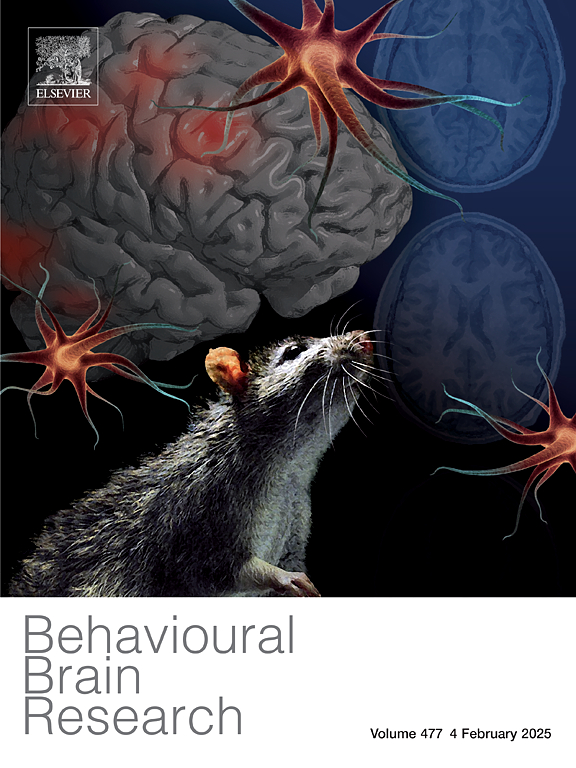Fstl1对脂多糖诱导的急性抑郁样小鼠神经炎症和小胶质细胞活化的影响。
IF 2.3
3区 心理学
Q2 BEHAVIORAL SCIENCES
引用次数: 0
摘要
抑郁症是最常见的精神疾病,其发病机制与神经炎症有关。卵泡他汀样蛋白1 (Follistatinlike protein 1, FSTL1)是一种新型炎症蛋白,参与神经炎症相关疾病的发病机制。因此,我们旨在通过神经炎症介导的模型来研究FSTL1在抑郁症发病机制中的作用。我们的研究结果表明,脂多糖(LPS)可以诱导雄性和雌性小鼠的绝望样行为并增加促炎细胞因子的水平。然后,在雄性小鼠中观察到海马Fstl1 mRNA表达、小胶质细胞激活和绝望样行为之间的显著正相关。敲低FSTL1可显著降低小胶质细胞的活化和促炎细胞因子的表达,而雄鼠海马区FSTL1过表达可加剧lps诱导下小胶质细胞的活化。机制上,敲低Fstl1抑制lps诱导的BV2小胶质细胞的激活,减少促炎细胞因子的产生,从而保护HT22神经元的存活。综上所述,我们的研究结果表明Fstl1可能通过调节小胶质细胞的激活和神经元活力来调节绝望样行为,为抑郁症的神经炎症机制奠定实验和理论基础。本文章由计算机程序翻译,如有差异,请以英文原文为准。
Effects of Fstl1 on neuroinflammation and microglia activation in lipopolysaccharide-induced acute depression-like mice
Depression is the most prevalent psychiatric illness, and its pathogenesis is associated with neuroinflammation. Follistatinlike protein 1 (FSTL1), a novel inflammatory protein, participates in the pathogenesis of diseases related to neuroinflammation. Therefore, we aimed to investigate the effect of FSTL1 in the pathogenesis of depression mediated using neuroinflammation-mediated models. Our results showed that lipopolysaccharide (LPS) administration could induce despair-like behavior and increase proinflammatory cytokine levels in both male and female mice. Then, a significant positive correlation between hippocampal Fstl1 mRNA expression, microglial activation and despair-like behaviors was observed in male mice. Moreover, knockdown FSTL1 significantly reduced microglial activation and the expression of proinflammatory cytokines, while overexpression of Fstl1 in hippocampus could exacerbate the activation of microglial under the LPS-induced condition in male mice. Mechanically, knockdown Fstl1 inhibited LPS-induced activation of BV2 microglia and reduced the production of proinflammatory cytokines, thereby protecting the survival of HT22 neurons. In conclusion, our results implied that Fstl1 may modulate despair-like behaviors through regulation of microglial activation and neuronal viability, which would lay the experimental and theoretical foundation for the neuroinflammatory mechanisms underlying depression.
求助全文
通过发布文献求助,成功后即可免费获取论文全文。
去求助
来源期刊

Behavioural Brain Research
医学-行为科学
CiteScore
5.60
自引率
0.00%
发文量
383
审稿时长
61 days
期刊介绍:
Behavioural Brain Research is an international, interdisciplinary journal dedicated to the publication of articles in the field of behavioural neuroscience, broadly defined. Contributions from the entire range of disciplines that comprise the neurosciences, behavioural sciences or cognitive sciences are appropriate, as long as the goal is to delineate the neural mechanisms underlying behaviour. Thus, studies may range from neurophysiological, neuroanatomical, neurochemical or neuropharmacological analysis of brain-behaviour relations, including the use of molecular genetic or behavioural genetic approaches, to studies that involve the use of brain imaging techniques, to neuroethological studies. Reports of original research, of major methodological advances, or of novel conceptual approaches are all encouraged. The journal will also consider critical reviews on selected topics.
 求助内容:
求助内容: 应助结果提醒方式:
应助结果提醒方式:


